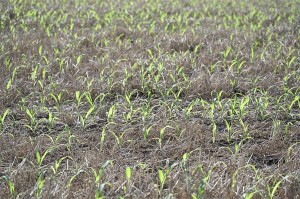Is ROI still king? Return on investment has long been the primary measure for evaluating product purchase decisions by farmers. The concept seems straightforward: a product delivers x amount more of yield or weight, you multiply the additional yield by the price you receive for your crop, then subtract the cost of the product. That’s how farmers evaluate and compare products for adoption, and even for continued use. But given today’s economic landscape, is ROI enough?
Farming is both a capital intensive and cash-flow challenging business. The vast majority of farmers require operating loans to purchase crop inputs such as seed, fertilizer, chemicals and fuel, as well as pay their labor and cash rent. They are often beholden to their ag lenders. To secure operating loans, farmers prepare and submit plans to their lenders, who in-turn assess risk. When financial risk is high, do-not-exceed loan limits are often set. In 2025, loans figure to be highly scrutinized, based on falling farm income projections. How will this impact the ag economy? As a manufacturer of crop inputs, you could make a case that your product delivers a 3:1 return, but if the farmer’s spending/borrowing capacity is capped, your product may not earn a place on the farm. Plus, in times like these, cost cutting can often supersede yield chasing. Thus, companies are now competing for share of wallet. In many cases, if a new product is allowed on the farm, an existing product must be removed or reduced. Instead of taking a category approach, farmers are taking an enterprise approach when evaluating what products they’ll purchase. Versatility will play an even greater role. For example, a biostimulant that can reduce rates of bulk fertilizers, act as a fertilizer stabilizer and deliver a yield bump will offer greater utility and stand a better chance for adoption. In challenging times, rules change. So while ROI may still be king, this year at least, it may be more in the mold of a King Charles.
USDA is getting a new leader. Brooke Rollins was chosen by President Trump to lead the department founded by Abraham Lincoln. Rollins grew up on a farm near Glen Rose, Texas, just southwest of Fort Worth and was a member of FFA and 4H. She attended Texas A&M (where she served as class President) and earned a degree in agricultural development. Best one can tell, that’s where her involvement with agriculture may have ended. She’s practiced law, directed think tanks and served in the previous Trump administration. By all accounts, she’s a capable administrator. But her lack of ag experience makes her appointment a curious choice. Rollins is regarded as a loyal follower of Trump, which appears to be a prerequisite in this administration. The US Secretary of Agriculture is a mighty big job. Per Senate approval, she will lead the 100,000-person department that operates on a $213 billion annual budget, while overseeing federal nutritional programs such as SNAP and WIC, farm subsidies, rural development, conservation policy and meat inspections. But nothing will be bigger than trade. Navigating Trump’s proposed tariffs on imports, which will likely lead to angst among trade partners, notably China, will be a heavy chore. China is our largest export market for ag products and US-imposed tariffs could once again disrupt that relationship. Rollins is currently CEO of the pro-Trump think tank America First Policy Institute. AFPI advocates curbing foreign ownership of farmland, especially by China. So she’s already more than knee-deep in Sino-American complexities. Of course, her first job will be winning the hearts and minds of the American farmer. To do so, she’ll need to go back to her roots.
Related Posts

This Week in Ag #11
You shouldn’t judge a book by its cover, but you can judge seed products by their bag covers. There’s lots of telling information on them. Just look at this bag of seeds going on my farm. The bag itself prominently features the brand name and logo (AgriGold), type of product (corn), the actual product name (A647-79VT2PRO) and

This Week in Ag #39
Clocks turned back one hour in most of the country over the weekend (a notable exception was Arizona). There’s a popular belief that daylight savings time was intended for farmers. Agriculturists are, of course, infamous early risers, said to awaken with the roosters to do their daily chores. Contrary to popular belief, the idea to “fall

This Week in Ag #43
December 8th is #NationalChristmasTreeDay. This of course sets up the great debate, real or fake? While every family weighs the pros and cons of choosing the Tannenbaum they rock around, a popular nation is that fake trees are more eco-friendly. After all, they can keep for many years, right? And isn’t it bad to cut down real trees merely for decoration? Not so fast.

